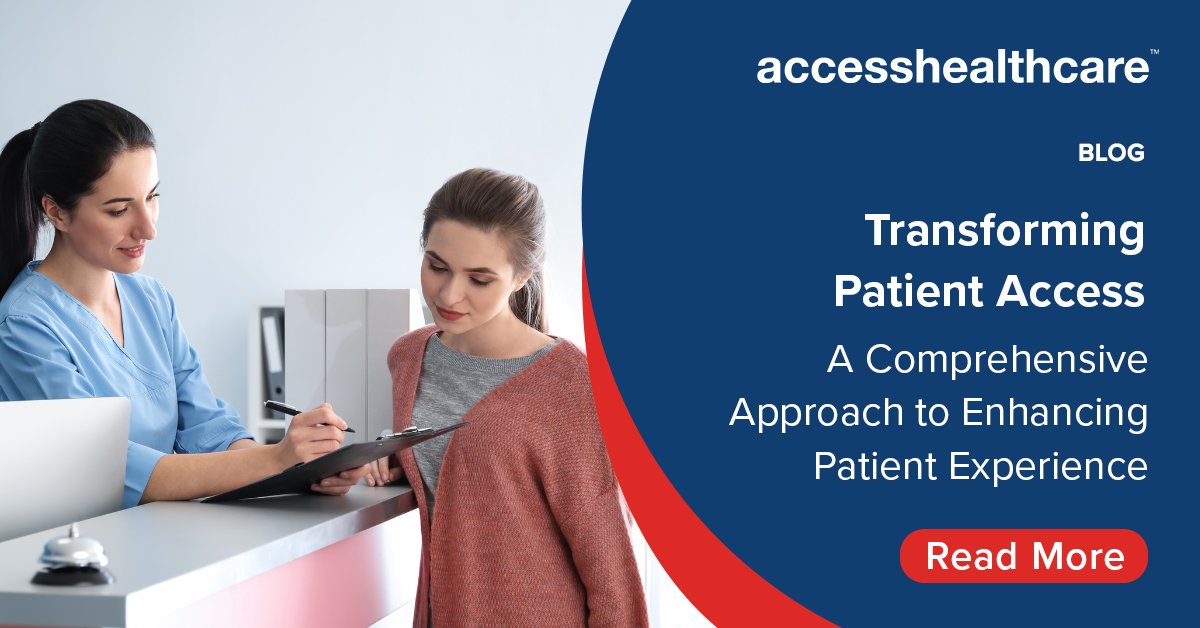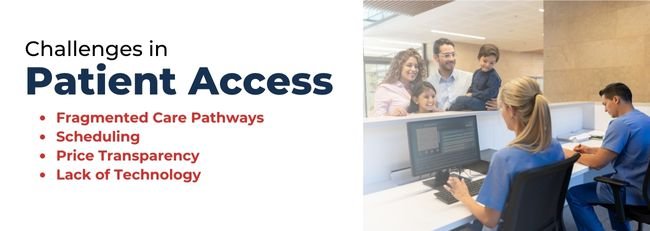A Comprehensive Approach To Enhancing Patient Experience
Patient experience has become crucial for success in the evolving US healthcare landscape. With the rise of healthcare consumerism, patients now demand more control, convenience, and transparency in their care. This article explores the importance of improving patient access and provides a comprehensive approach to enhancing the patient’s experience.
The Current State of Patient Access
Patient access, the gateway to healthcare services, currently faces several challenges:
Fragmented Care Pathways: Disjointed care processes often lead to patient dissatisfaction due to a lack of continuity in care. A recent survey revealed that 73% of patients found their healthcare journey fragmented and confusing (Source: HealthLeaders Media, 2023).
Inefficient Scheduling Systems: Outdated scheduling methods result in long wait times and appointment mismatches. On average, patients wait 26 days to schedule a physician appointment in 15 major US cities, according to the 2023 Survey of Physician Appointment Wait Times by WSHA.
Lack of Transparency: Patients are frequently unaware of treatment options and associated costs, leading to unexpected expenses and dissatisfaction. A 2024 McKinsey report suggests that with proper incentives and information, patients would be inclined to shop for healthcare services, potentially affecting 20 to 25 percent of US healthcare claims spend. This shift could unlock significant gains in affordability for consumers.
The Need for Transformation
The US healthcare sector is undergoing a paradigm shift:
Evolving Patient Expectations: Modern patients expect seamless digital experiences similar to those in banking or e-commerce. Currently, 80% of patients prefer digital solutions, including telehealth options.
Operational Efficiency: Implementing a streamlined patient access system can optimize resource utilization and lower operational costs. Institutions that have adopted such systems report a 30% reduction in operational expenses.
Competitive Differentiation: In a crowded market, prioritizing patient experience can set institutions apart from competitors. According to a Patient Engagement HIT study, 73% of patients indicated they would switch providers for a more consumer-friendly experience.
A Comprehensive Approach to Enhancing Patient Experience
To meet and exceed these evolving expectations, a multifaceted approach is essential:
Centralized Scheduling: Implementing a unified scheduling system can simplify the appointment booking process, allowing patients to manage their schedules more efficiently. Institutions that have adopted centralized scheduling report a 50% reduction in no-show rates, according to an MGMA article titled "Implementing Central Scheduling to Support Practice Growth and Success in the Accountable Care Environment."
Digital Front Door: Providing a one-stop digital portal empowers patients to access healthcare information, communicate with providers, and manage their health journey. An Accenture study found that 68% of patients are more likely to choose a provider that offers digital tools for managing their health.
Transparent Pricing: Clear pricing structures enable patients to make informed decisions about their care. An estimated 59% of patients seek pricing information before receiving care, and 40% compare prices between providers.
Transformation in Patient Access Call Centers
Patient access call centers have traditionally served as the initial point of contact for many patients. However, as the healthcare landscape evolves, the role and operations of these call centers are also transforming. This shift is driven by the need to enhance patient experience, streamline operations, and integrate with the broader digital healthcare ecosystem.
From Reactive to Proactive: Traditional call centers were primarily reactive, responding to patient queries as they arose. Modern call centers, however, take a proactive approach by reaching out to patients for appointment reminders, follow-ups, and health check-ins, thereby ensuring continuity of care.
Integration of Advanced Technologies: AI-driven chatbots, predictive analytics, and CRM systems have become integral components of call centers. These technologies help efficiently handle routine queries, predict patient needs, and personalize interactions.
Omni-channel Support: Beyond traditional voice calls, call centers now offer support via email, chat, video calls, and even social media. This multi-channel approach ensures that patients can interact with healthcare providers on platforms they are most comfortable with.
Data-Driven Insights: Modern call centers leverage data analytics to gain insights into patient behavior, preferences, and feedback. This data-driven approach allows for continuous improvement in service quality and patient experience.
Enhanced Training and Skill Development: The role of a call center representative has evolved from merely scheduling appointments to offering comprehensive patient support. This evolution necessitates regular training sessions to ensure representatives are well-versed in the latest healthcare protocols, communication skills, and technology tools.
Security and Compliance: With the increasing amount of patient data being handled, call centers are investing heavily in ensuring data security and compliance with regulations like HIPAA. This ensures that patient data is protected, and trust is maintained.
Collaboration with Healthcare Teams: Call centers are no longer isolated units. They now collaborate closely with healthcare professionals to ensure that patient queries related to treatments, medications, and health concerns are addressed promptly and accurately.
Focus on Patient Experience: The goal of these transformations is to enhance patient experience. From reducing wait times to ensuring personalized interactions, every change is geared towards making the patient's journey smoother and more satisfactory.
Implementing the Transformation
Transforming Healthcare Patient Access: A Comprehensive Journey
The transformation journey in healthcare, particularly in patient access, is complex and multifaceted. It requires a strategic approach built on a clear vision and unwavering commitment. Here are the key pillars of this transformative journey:
Stakeholder Engagement: Engaging all stakeholders, from clinicians to administrative staff, is crucial for the success of the transformation process. Their involvement ensures a comprehensive approach to change and fosters collaboration.
Technology Investments: Investing in modern technology platforms is essential to support and enhance patient experience transformations. The US healthcare IT market is projected to reach USD 270.3 billion by 2021, highlighting the importance of technological advancement.
Training and Development: Ensuring that staff have the necessary skills and understanding to navigate and champion new processes is vital. Continuous training and development programs help staff adapt to changes and maintain high standards of care.
This strategic approach to transforming patient access in healthcare focuses on engaging stakeholders, investing in technology, and prioritizing training and development to achieve a seamless and efficient healthcare experience.
Measuring Success
Ensuring Effective Transformation: Monitoring and Metrics
Regular monitoring is essential to ensure the transformation is progressing as planned. Here are key metrics to track:
Patient Satisfaction Scores: These scores provide insights into how patients perceive the changes. Patient-reported experience is associated with higher future revenue and lower costs of hospitals. Eur J Health Econ (2023).
Operational Metrics: Metrics such as wait times and no-show rates offer a snapshot of operational efficiency, helping to identify areas for improvement.
Financial Outcomes: Improved patient access can enhance patient retention, leading to greater financial success. Enhanced access typically translates to increased patient volume and revenue.
By regularly tracking these metrics, healthcare organizations can ensure their transformation efforts are on the right track and making a positive impact.
The Future of Patient Access
As technology continues to advance and patient needs evolve, patient access will undergo significant transformations. The integration of technology with a personal touch will be crucial, and comprehensive engagement partners will play an indispensable role in fostering growth.
Cultural Shift Towards Patient Experience: Transforming patient access involves more than just implementing new technologies or processes; it requires a cultural shift towards prioritizing the patient’s experience. By adopting a comprehensive approach, healthcare institutions can meet and exceed patient expectations, leading to enhanced satisfaction, operational efficiency, and financial success.
Healthcare institutions that embrace this holistic approach will be better positioned to adapt to changing patient needs and technological advancements, ensuring long-term success and improved patient outcomes.
About Access Healthcare
Access Healthcare stands as one of India's largest and fastest-growing providers of healthcare business processes and technology solutions. Our team of over 27,000 professionals operates from 20 service delivery centers across three countries, emphasizing global delivery, workflow optimization, and our award-winning AI-enabled technology platform.
Since 2011, Access Healthcare has been a trusted partner to the US healthcare sector, leveraging domain expertise, technology, automation, and analytics to enhance clinical outcomes, financial performance, and operations for healthcare providers and payers.




